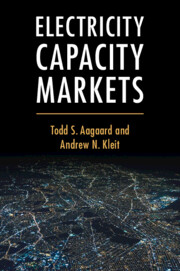Book contents
- Electricity Capacity Markets
- Electricity Capacity Markets
- Copyright page
- Contents
- Figures
- 1 Introduction
- 2 Capacity Markets Primer
- 3 Restructured Electricity Markets and Regional Transmission Organizations
- 4 Reliability and the Missing Money Problem
- 5 Capacity Policies
- 6 First-Generation Capacity Markets
- 7 Second-Generation Capacity Markets
- 8 Capacity Market Demand
- 9 Capacity Market Supply
- 10 Capacity Market Design
- 11 Market Power
- 12 Minimum Offer Price Rules
- 13 The Texas Alternative
- 14 Conclusion
- Index
- References
1 - Introduction
Published online by Cambridge University Press: 24 February 2022
- Electricity Capacity Markets
- Electricity Capacity Markets
- Copyright page
- Contents
- Figures
- 1 Introduction
- 2 Capacity Markets Primer
- 3 Restructured Electricity Markets and Regional Transmission Organizations
- 4 Reliability and the Missing Money Problem
- 5 Capacity Policies
- 6 First-Generation Capacity Markets
- 7 Second-Generation Capacity Markets
- 8 Capacity Market Demand
- 9 Capacity Market Supply
- 10 Capacity Market Design
- 11 Market Power
- 12 Minimum Offer Price Rules
- 13 The Texas Alternative
- 14 Conclusion
- Index
- References
Summary
Imagine a scenario in which there is great concern for maintaining an adequate number of grocery stores to serve the food-purchasing public around the clock, so that consumers always have access to open grocery stores to buy food. In response to this concern, a new revenue stream is created for grocery stores. Previously grocery stores earned their revenues entirely from consumer purchases of food. Now consumers will also be required to pay in advance to ensure that grocery stores will be open for business twenty-four hours per day. Grocery stores will receive these payments from consumers merely for being open, even if no consumers buy any food. These new payments to grocery stores do not entitle consumers to purchase food at any particular price from the stores. The grocery stores’ only obligation is to be open for business, ready to sell food.
- Type
- Chapter
- Information
- Electricity Capacity Markets , pp. 1 - 9Publisher: Cambridge University PressPrint publication year: 2022

